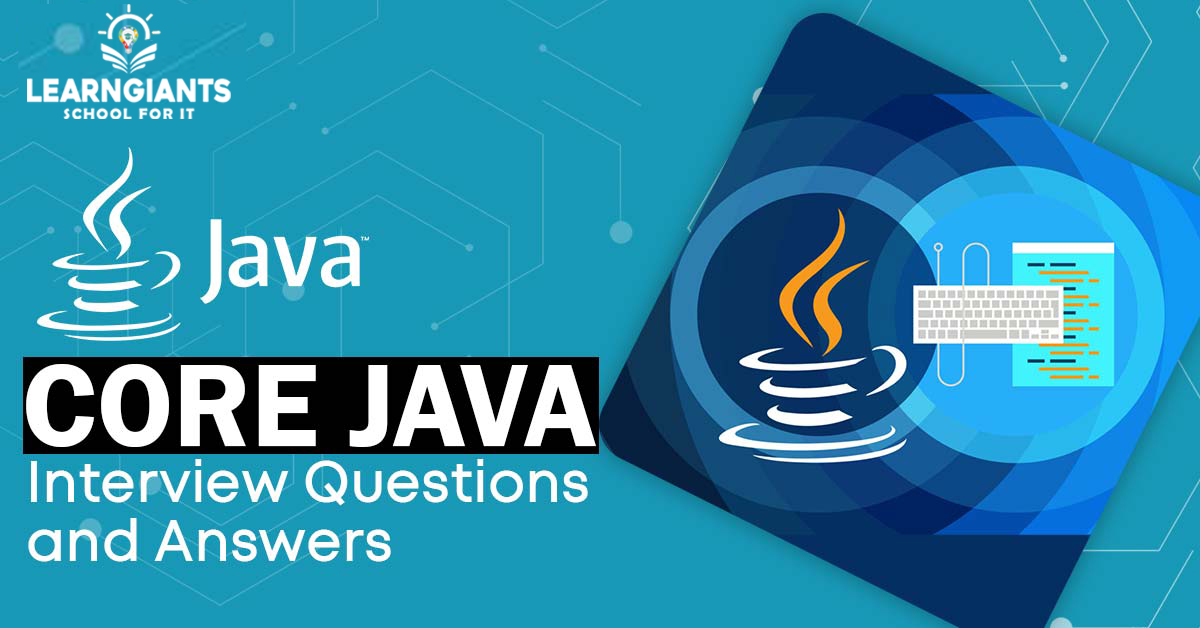Java Interview Questions and Answers

1. What is Core Java?
Java is a high-level, object-oriented, scalable, stable software application and a multithreaded and moving programming language that is platform-independent and powerful.
2. What do you mean by Java Virtual machine?
Java Virtual Machine is a software machine that can operate the Java application from your cpu. JVM serves like an executive engine naming the central Java application process. JVM is the operating device specification that will be enforced. Java is a bytecode that is separate from the computer and loosely related to the native code.
3. What are the features of Core Java?
4. Explain Java Runtime Environment
It is the JVM's execution. The Java Runtime Environment is a collection of development utilities for Android programs. It is used to provide the atmosphere for runtime. This is the JVM's operation. It remains biologically. It includes a collection of libraries + other files used by JVM.
5. Explain classloader
Classloader is a JVM module for accessing class directories. The class loader is the first one that is enabled while we run the java application.
6. Explain object-oriented paradigm
It is a theory of programming focused on artifacts with methods and techniques specified in the category its corresponds to. Object-oriented design aims at combining modular design and maintainability benefits. Objects are entity instances that engage in developing applications and programs
7. What is an object?
The object is the subject of certain condition and action in real time. Throughout Java, Object is an entity instance with the instance variables as model state and methods as the model 's actions. You will construct the object of a class using the new keyword.
8. Explain constructor
The constructor can be described as the specific form of method used in initializing an object's state. This is required where the assignment is immediate and the memory for the item is allocated. The default unit builders are named when an entity is generated using the new keyword.
9. What is the default constructor used for?
The default constructor purpose is to give artifacts the default meaning. The java compiler automatically generates a default builder if no builder is found in the package.
10. Explain static variable
The static variable applies to the universal property of all topics, e.g. workers' company names, college names, etc. Just once is the static attribute in the configuration field when launching the file. Using a static feature, you traverse the memory capacity of the software. The static variable does not apply to the subject but to the class.
11. Explain JIT compiler
JIT reflects Java's Just-in-Time compiler. This is a software to transform the bytecode Java into instructions sent to the processor directly. JIT compiler is disabled in Java by design and enabled as soon as a Java method is named. The JIT compiler then compiles the bytecode of the process called into machine code and then collates it "on time."
12. Explain Oops in Java & concepts
Inheritance: heritage is a phase where the features of another
community are obtained. Encapsulation: Java encapsulation is a
method for the integration of data and code in a single
package.
Abstraction: Abstraction is the technique to cover the user's
knowledge of the application and just give the consumers the
features.
Polymorphism: polymorphism is the capacity to take several types
of a element, function or entity.
13. What is Java String Pool?
Java String pool applies to a list of strings contained in the storage of a stack. In this, the string pool must first test whether or not the item is present in the pool when a new object is formed. If current, the same reference is provided to the entity, then in the String pool the new value is generated and the corresponding reference is retrieved.
14. What do you mean by Map?
Map is a specific user software mapping specific values element. The Map module is not a component of the central framework for the series and is thus no different from the others.
15. Explain Polymorphism
The concept 'one interface, multiple application' is briefly defined in Polymorphism. Polymorphism is the attribute that causes an element, such as a vector, process or event to have more than one type, to give a particular definition or use to it in varying contexts.
16. Explain Interface
The interface in Java is a feature model or, whether it's an abstract and static specification, it can be told. Every approach is available and abstract in an app, but does not have a building tool.
17. What is Inheritance?
Java inheritance is the definition in which one class may have the property of the other. This allows reusing the code and creating a connection between different groups.
18. Explain encapsulation
Encapsulation is a process through which you tie together as one entity your data and your code(methods). There the data can only be obtained through the current class methods and is concealed in the outer world. It helps to avoid unwanted adjustments to the results. Encapsulation in Java can be done by: Definition of the class variables as individuals. Provide public setup and getter methods for adjusting and displaying variable values.
19. What do you mean by marker interface?
An interface marker can be described as an application that has no user member functions. A void device is commonly regarded as the Marker gui. In Java, Marker is the most common form of serializing, cloning etc.
20. Explain aggregation
An aggregation is a specific interaction type in which any entity has its own lifecycle, yet the property and the child entity cannot belong to any parent object. Taking Office and instructor instances. A specific individual can not contribute to several agencies, but the instructor entity would not be lost when we delete it
21. What is the main benefit of Encapsulation?
The biggest value of encapsulation is that we are free to alter our application without affecting other users who use our technology. Through this encapsulation, our application can be preserved, modular and expanded.
22. What do you mean by an array?
An array is a set number of papers compiled in a community. Array is a homogeneously defined data form, which ensures that many same-type values can not be stored in an array but multi-type values can not. For illustration, an int style array may contain only integer values.
23. Explain Multithreading
This is a method of concurrently executing two or more programs. Threads are classified for growing of those pieces. In brief, several threads are executed concurrently as multithreading.
24. What is Java Package?
The Java package is the framework for the aggregation and organizing of java modules. The classification principle can be focused on functions or packages. A protected Java name contains module and class description.
25. What are Java Annotations?
Java Annotations contain application details and do not explicitly impact the application they are annotating. Java 5 presents annotations. Annotation is the documentation of the software itself included. The parser method or the compiler will be interpreted. We may also define the availability of annotations only to compilation or to operate.

 WhatsApp Us
WhatsApp Us